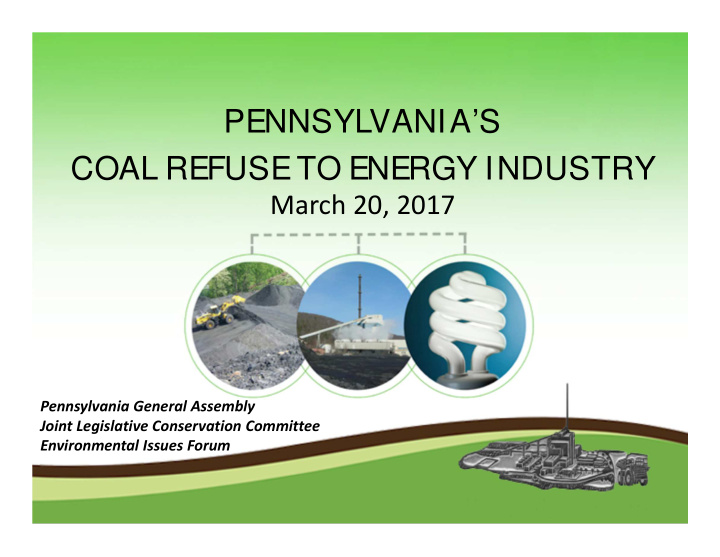



PENNSYLVANIA’S COAL REFUSE TO ENERGY INDUSTRY March 20, 2017 Pennsylvania General Assembly Joint Legislative Conservation Committee Environmental Issues Forum
Olympus Power, LLC 4 Coal Refuse Fired Generation Projects in Pennsylvania ‐ 311 MW Project Location (MW) Northampton Coal Refuse Northampton, PA 114 Reclamation & Remediation Panther Creek Coal Refuse Nesquehoning, PA 80 Reclamation & Remediation Westwood Coal Refuse Tremont, PA 30 Reclamation & Remediation Scrubgrass Coal Refuse Scrubgrass, PA 87 Reclamation& Remediation
How Does Olympus View the Coal Refuse Energy Industry? Why are coal refuse energy plants unique? We like to view these facilities as environmental remediation and reclamation businesses that sell electricity to pay for the beneficial environmental work that we do. How do we view these plants from the stand point of environmental conservation? The Coal Refuse Energy facilities represent the most environmentally beneficial technology with which we have ever been associated. The coal refuse problem that we address in Pennsylvania is severe and the environmental benefits that we produce are tangible, measurable and immediate.
What is the Coal Refuse Problem? Why Should We Care?
Coal Refuse Piles Represent Uncontrolled Water and Air Pollution
Coal Refuse Piles Represent: Watershed impacts Acidic mine water Iron and Iron oxide pollution Metals contamination Uncontrolled fires Air pollution Wild fires High cost to local community budgets from first responders State emergency management funding also hit hard Uncontrolled dust and particulate matter pollution Residential hazards and injuries
How big is the problem? No one really knows… Three classes of refuse sites Abandoned mine land [AML] inventory Bond forfeiture sites Active sites Could be between 300 million cubic yards to 8 billion cubic yards of coal refuse alone We think it’s about 2 billion cubic yards split almost evenly between the anthracite and bituminous regions of PA
Affected Watersheds
Affected Communities In Pennsylvania
Swoyersville Borough, Pennsylvania Downtown Swoyersville, PA, includes one of the thousands of Coal Refuse piles afflicting PA’s communities. This community, as well as those down stream and down wind, are all adversely affected by this environmental blight.
A Uniquely Pennsylvania Solution
There are Three Stages to the Beneficial Refuse to Energy Environmental Reclamation Process Removal Remediation Reclamation How does this process work?
Challenges
Challenging Business Environment Facing the PA Coal Refuse Energy Industry PA coal refuse ‐ fired electricity generation units are electric wholesale generators not rate ‐ based electric utility assets Participation in the PJM market, a declining and volatile energy and declining capacity pricing environment Abundant & inexpensive shale gas has driven down electricity pricing to levels at which coal refuse facilities are under severe economic pressure The cost of environmental allowances and emissions fees must be added to the bid price Challenge to maintain high combustion efficiency in low quality fuel environment is a risk factor
Operating Challenges Facing the PA Coal Refuse Energy Industry Restricted access to coal refuse sites Ownership unmotivated to cooperate in removal Local residents anxious and often resistant to change Successful removal of fuel immediately adjacent to existing facilities has resulted in fuel scarcity at required quality (heating value/sizing) Need to reach farther afield for coal refuse as our fuel – results in higher fuel acquisition costs and increased transportation costs
Regulatory Challenges Facing the PA Coal Refuse to Energy Industry Environmental compliance costs, including the price of allowances, generally drive up capital expenditures and the price bid into the market Cross ‐ State Air Pollution Rule Update (CSAPR) – Ozone Season NOx emissions issue Mercury and Air Toxics Standards (MATS) – Due to high sulfur levels in the bituminous refuse fuel, 4/5 of these plants will close if not resolved by April 16, 2019. The issue for the anthracite facilities is the cost of frequent testing to show they are low emitting EGUs. PA DEP is considering a re ‐ set of Title V Emission Fees , potentially including CO2 Spurious Petitions filed by States such as MD, DEL, CT, NY against facilities in PA without a “demonstration of need”
PJM Market Challenges PA coal refuse ‐ fired EGUs participate in the PJM wholesale electric energy and capacity markets and must recover all costs from those market bids PJM energy market pricing reflects abundant and cheap natural gas and the mandated use of other “renewable” electric resources Declining capacity pricing places all generation facilities at risk of under funding necessary capital expenditures and creates the preconditions for a deterioration of systemic reliability PJM capacity market has been negatively influenced by the policy decisions of EPA and FERC
Conclusion There are only 14 Coal Refuse to Energy Remediation and Reclamation Facilities in PA – no new plants will be built – a precious PA resource This is the only private sector industry that is capable of holistically and cost effectively addressing the coal refuse issue We work closely with the PADEP and provide a private sector solution to a major issue threatening the environment of PA The industry is threatened by government policies and market forces outside of its control We require the steady support of the PA House and Senate to ensure the continued success of this unique Pennsylvania – Public – Private – Partnership We are grateful for your passage of the critical Coal Refuse Tax Credit in the 2016 ‐ 17 PA Budget and would appreciate your strong support for our industry in the upcoming Budget deliberations
Thank You Sean P. Lane EVP Government Affairs General Counsel & Secretary Olympus Power, LLC 973 ‐ 753 ‐ 0181 slane@olympuspower.com
Recommend
More recommend